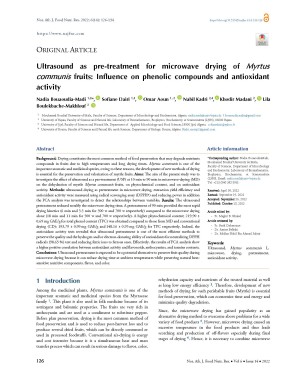Ultrasound as pre-treatment for microwave drying of Myrtus communis fruits: Influence on phenolic compounds and antioxidant activity
Abstract
Background: Drying constitutes the most common method of food preservation that may degrade nutrients compounds in fruits due to high temperatures and long drying times. Myrtus communis is one of the important aromatic and medicinal species, owing to these reasons, the development of new methods of drying is essential for the preservation and valorization of myrtle fruits. Aims: The aim of the present study was to investigate the effect of ultrasound as a pre-treatment (USP) at 10 min to 90 min in microwave-drying (MD) on the dehydration of myrtle Myrtus communis fruits, on phytochemical content, and on antioxidant activity. Methods: ultrasound drying as pretreatment in microwave drying, extraction yield efficiency and antioxidant activity were measured using radical scavenging assay (DPPH•) and reducing power in addition the PCA analysis was investigated to detect the relationships between variables. Results: The ultrasound pretreatment reduced notably the microwave drying time. A pretreatment of 90 min provided the most rapid drying kinetics (6 min and 5.5 min for 500 w and 700 w respectively) compared to the microwave drying alone (18 min and 11 min for 500 w and 700 w respectively). A higher phytochemical content; 219.90 ± 0.69 mg GAE/g for total phenol content (TPC) was obtained compared to those from MD and conventional drying (CD); 193.79 ± 0.99 mg GAE/g and 148.16 ± 0.95 mg GAE/g for TPC respectively. Indeed, the antioxidant activity tests revealed that ultrasound pretreatment is one of the most efficient methods to preserve the quality and the hydrogen and/or electron-donating ability of antioxidants for neutralizing DPPH radicals (98.63 %) test and reducing ferric ions to ferrous ones. Effectively, the results of PCA analysis show a higher positive correlation between antioxidant activity and flavonoids, anthocyanins, and tannins contents. Conclusions: Ultrasound pretreatment is expected to be a potential alternative to preserve fruit quality during microwave drying because it can reduce drying time at ambient temperatures while preserving natural heat-sensitive nutritive components, flavor, and color.
Full text article
Authors
Copyright (c) 2022 Nadia BOUAOUADIA-MADI, Sofiane DAIRI, Omar AOUN, Nabil KADRI, Khodir MADANI, Lila Boulekbache-Makhlouf

This work is licensed under a Creative Commons Attribution 4.0 International License.
-
Attribution — You must give appropriate credit, provide a link to the license, and indicate if changes were made. You may do so in any reasonable manner, but not in any way that suggests the licensor endorses you or your use.
-
No additional restrictions — You may not apply legal terms or technological measures that legally restrict others from doing anything the license permits.





